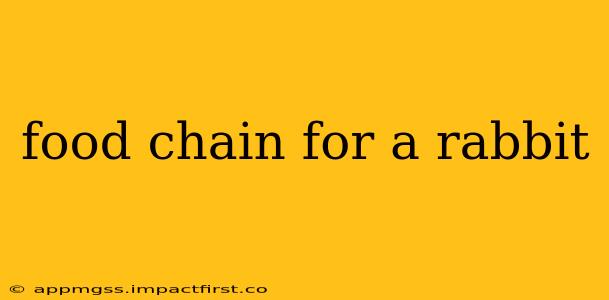Rabbits, those adorable, hopping creatures, play a vital role in various ecosystems. Understanding their place in the food chain is crucial to appreciating their ecological impact and the delicate balance of nature. This comprehensive guide will explore the rabbit's position, detailing what they eat, who eats them, and the interconnectedness of this seemingly simple food chain.
What do rabbits eat? (Their place as primary consumers)
Rabbits are herbivores, meaning their diet consists entirely of plant matter. This makes them primary consumers in the food chain, occupying the second trophic level. Their diet predominantly includes grasses, clover, alfalfa, dandelions, and other leafy greens. They also consume bark, twigs, and roots, depending on the season and availability. The specific plants a rabbit consumes depend heavily on its geographic location and the plants available in its habitat. This dietary diversity is crucial for maintaining their health and obtaining necessary nutrients.
What eats rabbits? (Their predators)
Rabbits, despite their seemingly harmless nature, are a crucial food source for numerous predators. This makes them prey animals, vulnerable to attack at various life stages. Their predators vary depending on their geographic location and habitat. Common predators include:
- Foxes: These cunning canids are highly adept at hunting rabbits, employing stealth and quick reflexes.
- Coyotes: Larger and more powerful than foxes, coyotes are formidable predators, capable of taking down adult rabbits.
- Hawks and Owls: Birds of prey, particularly those with sharp talons and excellent eyesight, are significant threats to rabbits, especially young or vulnerable individuals.
- Weasels and Stoats: These agile and fierce carnivores are skilled hunters that can effectively pursue and capture rabbits.
- Snakes: Certain snake species, particularly larger constrictors or those with venom, can prey on rabbits.
- Domestic Cats: While not natural predators in the wild, domestic cats, particularly those allowed to roam freely, often pose a threat to rabbit populations.
What are the secondary consumers in a rabbit's food chain?
The secondary consumers are the animals that eat the primary consumers (the rabbits). This would include all the predators listed above: foxes, coyotes, hawks, owls, weasels, stoats, snakes, and even domestic cats. These animals occupy the third trophic level in the food chain.
What happens when the rabbit population increases or decreases?
Fluctuations in rabbit populations directly impact the populations of their predators. An increase in rabbits leads to an increase in predator populations, as there's more food available. Conversely, a decrease in rabbits can lead to a decline in predator numbers due to food scarcity. This demonstrates the interconnectedness and delicate balance within the ecosystem.
How does habitat loss affect the rabbit food chain?
Habitat loss significantly affects the rabbit food chain. The destruction of natural habitats reduces the availability of food sources for rabbits, leading to a decrease in their population. This, in turn, affects the populations of their predators, potentially leading to imbalances within the ecosystem.
Are there any diseases or parasites that affect rabbits and their predators?
Yes, rabbits and their predators are susceptible to various diseases and parasites. These can have a profound impact on population numbers, affecting the overall balance of the food chain. For example, diseases that weaken rabbit populations can reduce food availability for predators, while diseases that affect predators can lead to increased rabbit populations.
What is the role of decomposers in the rabbit food chain?
Decomposers, such as bacteria and fungi, play a crucial role in the rabbit food chain. They break down the remains of dead rabbits and other organisms, returning essential nutrients to the soil, which then supports the growth of plants that rabbits consume. This completes the cycle, illustrating the interconnectedness of all levels within the ecosystem.
By understanding the rabbit's place within its food web, we gain a deeper appreciation for the intricate relationships and delicate balance within natural ecosystems. The rabbit's simple yet crucial role highlights the interconnectedness of all living things and the importance of preserving biodiversity.
